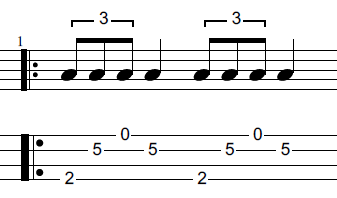I’m a big fan of campanella style picking on the ukulele and of Jonathan Lewis’s playing. So it’s no surprise I love Jonathan’s new ebook Irish Tunes for Campanella Ukulele. It’s a great selection of arrangements.
I asked Jonathan if he’d like to do a guest post and he was kind enough to agree. So here’s a primer on campanella playing and tab for his arrangement of The Blarney Pilgrim.
Many of us who play ukulele first started on the guitar, and we fell in love with this instrument because of its cheerful image, its versatility and its portability – it weighs virtually nothing and takes up no space. But what really makes the ukulele so special? For me it has to be re-entrant tuning, which makes campanella picking possible.
So what exactly is campanella? It actually means “little bell” and that’s the effect we’re trying to get – when you hear church bells, one doesn’t stop ringing before the next one starts – they all ring at the same time. The same for a harp. A harp doesn’t have a neck where you can put your fingers to change the pitch of a string, so one string, one note. On the ukulele (charango and baroque guitar too), campanella picking means avoiding playing two notes on the same string whenever possible, taking advantage of the re-entrant tuning, where two strings are only one tone apart. Using open strings as much as you can and alternating between strings rather than playing successive notes on the same string really does make the uke sound like a little harp.
Listen to a few scales played in the campanella style.
Why campanella is best for traditional tunes
Fiddlers, whistlers and bagpipers have a whole bunch of tricks to make simple tunes sound more interesting. Ornamentation is always a bit hit and miss on fretted instruments but the harp-like sounds you get from campanella can make up for this. And you can always insert into your campanella picking the odd hammer-on, pull-off or slide to ornament your tunes.
Practice: The Blarney Pilgrim
Let’s look at the popular jig, the Blarney Pilgrim. Play the first four bars like this (non-campanella):
Then play the same melody like this (campanella):
Notice how you can always hear more than one string ringing at the same time? That’s the beauty of campanella. And it’s all thanks to re-entrant tuning. I completely get it that some people prefer to have a low G on their uke (lots of people own more than one uke so they can have both) – you can do a lot more in terms of accompanying your own melodies or if you’re singing.
Campanella gives the melody first place
And rightly so. That’s what music is all about. Even in classical music, the most popular pieces are the ones that people can whistle or hum. So what’s wrong with playing a single-line melody on your uke? Maybe you think that it sounds thin or weak, in that case get a friend to play along with you. I’m not talented enough to be a one-person-band but the upside to that is social: I can always get friends to play chords for me or I’ll play chords for them.
Learn the Blarney Pilgrim in Campanella style
Earlier I showed you one line from this traditional Irish tune, so now here is the full tune. You can download the tab here:
The Blarney Pilgrim (Tab)
A few tips on playing campanella
1. Use keys where you’ll use open strings. As the open strings on a uke make a C6 chord (or Am7 if you prefer) it’s probably best to arrange in keys that use a minimal number of sharps or flats.
2. Look for shapes and use barres so you can keep those strings ringing.
3. You won’t always be able to find a suitable campanella fingering. Don’t get obsessed with campanella – sometimes it’s better to play two notes on the same string rather than a difficult or clumsy campanella fingering.
4. Think about where you can play the same notes in different places. For example, a triplet of As could be played like this:
Author Bio:
Jon has been a fanatical ukulele player since discovering campanella fingerpicking. As a guitarist he is fascinated by open tunings, mainly because he wished he could have been a harpist! Since learning campanella tunes and arpeggios from ukulelesecrets.org (Tim Keough) Jon spends too much of his free time arranging traditional tunes for campanella ukulele. You can get his collection of Irish tunes here.






This made me smile, Al. Thank you. When I first started playing uke I found John King’s book and immediately liked campanella-style playing. Since then I most always prefer playing different strings over straight-line playing, and always use the G string instead of E3 (I had to learn from you that it can be the bass line). Thanks for being third-party confirmation. You rock. I mean, you ring.